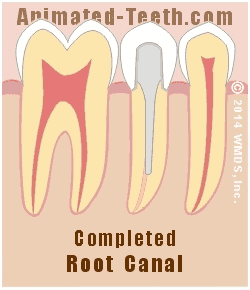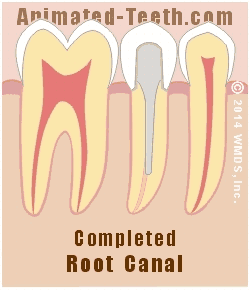Alternatives to having root canal treatment.
What are the alternatives to having a root canal?
The answer to this question has a few component parts:
#1 – There is no dental procedure that even remotely duplicates the goals and purposes of performing endodontic therapy. Therefore, no truly equivalent alternative exists.
#2 – Since not having root canal therapy perpetuates an unpredictable situation. One where infection associated with the tooth places you at risk of serious complications (either now or in the future). The only alternative to not having it that also removes your risk of experiencing problems is tooth extraction.
#3 – Once a decision is made to extract rather than treat your tooth, you then have several options and alternatives in how your missing tooth is replaced. This includes placing a dental implant, bridge, or partial denture, or even not replacing the tooth at all.
If root canal therapy isn’t chosen, why is the only alternative tooth extraction?
Background: The goals and purposes of root canal treatment.
Endodontic therapy is a very unique dental procedure and one whose goals and purpose Detailed explanation. are not duplicated by any other kind of dental work. In a nutshell …
- It’s used to treat teeth that have advanced nerve-space complications.
[Frequently these kinds of problems are a result of pulp exposure (the tooth’s nerve was nicked when a deep cavity was filled), infected pulp tissue (sometimes caused by severe tooth decay or other severe damage or breakage), or dental trauma (like the tooth being bumped in an accident or having repeated restorations placed).]
- Performing it resolves tooth pathology such as irreversible pulp tissue inflammation and tooth infection. It also alleviates the symptoms (pain, swelling) that these conditions may have caused.
- When completed, the inside of the tooth (its pulp chamber and root canals) is filled in and sealed off using a bio-compatible material (termed gutta-percha). It creates a barrier that prevents oral bacteria and other contaminants from penetrating into the tooth’s treated nerve space, the result of which would be renewed infection and continued complications.
And that’s why an extraction is indicated.
Since no other type of dental work can create the same kind of permanent solution for a tooth’s nerve space problems as endodontic therapy can, when it’s not chosen the only other option is to have your tooth pulled. Otherwise, you would experience persistent, possibly serious, complications with it. (Hargreaves)
What tooth-replacement alternatives do you have if you decide not to have a root canal?
Just because you’ve had a tooth extracted instead of root canalled doesn’t mean that you have to remain toothless. You have several alternatives in how your missing tooth is replaced. Your options include:
In some cases, Orthodontic Treatment might be used to close in the missing tooth’s space (rather than placing an artificial tooth).
What about not replacing the tooth?
Choosing extraction rather than having root canal therapy and then not having the pulled tooth replaced is typically considered the poorest choice. We explain why below.
▲ Section references – Hargreaves
Treatment (tooth replacement) alternatives to root canal therapy –
Something to think about …
While extract and replace options do exist, salvaging your tooth and then having it rebuilt The Process is often the less costly (see comparisons below), less painful, and less time-consuming option.
It also results in a more natural and familiar outcome, as opposed to having some type of artificial/mechanical tooth placed. So, if your dentist thinks it’s a good idea, give saving your natural tooth some serious consideration.
With replacement dental work, make sure you know what you’re getting.
If you do lean toward extraction and replacement, during your consultation with your dentist, be sure to ask a lot of questions about what your new artificial tooth will be like.
Artificial teeth are different.
Saving your tooth by way of having root canal therapy is a way of preserving the status quo. In comparison, any type of replacement tooth will, at least in some way, be different than what you have now. We try to explain these differences in our text below but, also, make sure you ask your dentist any questions you have.
Option #1: Dental implant placement.
Just a few decades ago this treatment option didn’t even exist. Nowadays, this alternative is chosen so often that we’ve dedicated a page just to this topic: Dental implant vs. root canal. Which makes the better choice?

Having a root canal vs. a dental implant.
Dental implant placement as compared to having root canal treatment.
1) Overall treatment time frame.
As opposed to opting for an implant, saving your tooth via root canal treatment can likely be completed within a shorter overall time frame.
- Implant cases often require some months for the healing process alone. However, this waiting period isn’t always necessary. (Only your dentist can determine what’s needed for your case.)
- In comparison, from start to finish, performing a tooth’s root canal procedure and creating whatever type of final restoration is needed afterward should be able to be completed within a time frame of 30 days or so.
2) What’s having an implant like?
Some people may notice a few subtle differences between their original natural tooth and their new implant. This includes things like the way it’s explored by their tongue, the way debris tends to accumulate around it, or how it must be cleaned.
For most people, however, these issues should be just minor. An implant is generally considered the most natural-like type of replacement tooth and typically takes no time to get used to.
… as compared to other kinds of artificial teeth.
The way a dental implant fuses with the jawbone Osseointegration. makes it the most life-like type of replacement tooth. (It’s very solid. There’s no space underneath it.)
– A dental bridge may be as solid but a minute space exists between the gum tissue and its artificial tooth. Keeping this space clean can be tedious.
– A partial denture will not be as secure as an implant. And food and debris will tend to accumulate underneath it.
As compared with other tooth replacement techniques, placing an implant does not involve altering (trimming) neighboring teeth.
3) Cost comparison.
Using dental fee estimates from our website, we estimate that an implant approach (extraction + implant placement + implant abutment + dental crown) would cost roughly 50% more than a root canal one (molar root canal + dental post and core + dental crown – the most expensive scenario possible).
Notes – Molars have the highest root canal fee. Additionally, not all teeth will require a post and core, or possibly even a dental crown. So a lower fee for many cases would be likely.
If a dental plan or insurance is involved, you’ll need to check what procedures are covered. For example, some policies may not cover dental implants.
For a scholarly evaluation of this topic, use this link: Root canal vs. implant – Which is the more cost-effective option? Pros / Cons
Option #2 – Dental bridge placement.
A dental bridge is another way to replace a tooth that was extracted instead of root canalled. As its name implies, a bridge spans the space of the missing tooth. Until implants came into vogue, this method was generally considered the preferred way to replace missing teeth.

Having endodontic therapy vs. a dental bridge.
Dental implant placement as compared to having root canal treatment.
1) Overall treatment time frame.
Saving your tooth via root canal treatment can probably be completed in a slightly shorter overall time frame as compared to extracting it and placing a dental bridge. (1 month vs. 1 1/2 to 2 months.)
That’s because a dentist will usually want to wait at least 30 days after an extraction for bone healing to take place Healing timeline. before creating the permanent bridge for that space.
2) What’s having a dental bridge like?
A bridge is a very solid type of restoration but it’s more tedious to maintain than a natural tooth. Dental floss must be used to clean underneath the bridge’s artificial tooth (pontic).
… as compared to other kinds of artificial teeth.
- When a bridge is made, the teeth on either side of the missing tooth’s space are trimmed down. (Just like for a dental crown. The steps.)
When pristine teeth are involved, this results in the loss of healthy natural tooth structure. That’s OK if needed but alternatives like a dental implant (or even, somewhat, a removable partial denture) don’t require this sacrifice.
- Like a dental implant, a bridge is fixed firmly in place and is not removable.
3) Cost comparison.
- Using our fees index, we estimate that a dental bridge approach (extraction + 3-unit bridge) would cost roughly 25% more than a root canal one (molar root canal + dental post and core + dental crown – the most expensive scenario possible, see below).
- In regard to the above calculation, the bridge costs would be the same for replacing any tooth. In comparison, molars have the highest root canal fee. Additionally, not all teeth will require a post and core, or possibly even a dental crown. So in many cases, the fee would be less.
- If a dental plan is involved, an evaluation of its benefits and possible restrictions on what types of dental procedures are covered needs to be evaluated before a decision is made.
Option #3 – Removable partial denture.
A removable partial denture is an appliance that has one or more artificial teeth attached to it. When it’s slipped into place, its artificial teeth fill in the spaces of the person’s missing natural teeth.
1) Overall treatment time frame.
A root canal treatment approach can probably be completed within a slightly shorter overall time frame as opposed to extraction and partial denture construction. (1 month vs. 1 1/2 to 2).
That’s because a dentist will usually want to wait at least 30 days after pulling a tooth (so to allow for jawbone healing) before creating a removable partial that fills in its space.
2) What’s wearing a removable partial denture like?
It should be easy to imagine how having a removable appliance is different than having your own natural tooth (which is what you still have if you opt to have root canal therapy). People certainly do, however, adapt to wearing partials and can do quite well with them.
… as compared to other replacement techniques.
- A dental bridge or tooth implant is firmly fixed in place, a removable partial denture is not. This is a big difference.
A bridge or implant may ultimately feel like a natural tooth to you. But even though you may become accustomed to wearing a partial, you’ll always consider it an appliance that’s worn.
- Over the long term, a partial may create a wedging and loosening effect on the wearer’s teeth. This is not an issue with a bridge or implant.
- Removable partial dentures typically arch around and grasp onto teeth on both sides of a person’s mouth (left/right). They’re designed this way because it improves their retention and stability. That means, as compared to a bridge or an implant, wearing one can seem like a mouthful.
- For all of these reasons, most people would probably prefer having a bridge or implant over a removable partial denture.
3) Cost comparison.
- Using our dental costs index, we estimate that a removable partial denture approach (extraction + cast partial denture) would cost roughly 30% less than a root canal one (molar root canal + dental post and core + dental crown – the most expensive scenario possible, see below).
- In regard to the above calculation, the partial denture costs would be the same for replacing any tooth.
In comparison, molars have the highest root canal fee. Additionally, not all teeth will require a post and core, or possibly even a dental crown. With these considerations, in some cases, one could expect a root canal approach to be the less expensive scenario.
- If a dental plan is involved, an evaluation of its benefits and possible restrictions on what types of dental procedures are covered needs to be evaluated before a decision is made.
Option #4 – Orthodontic treatment.
Extracting a tooth that needs root canal therapy and then closing in the space that remains via orthodontic treatment may make a workable alternative in some cases.
There will be a number of dental issues that will play a role in determining the feasibility of this approach. And it will be a relatively special case where it can be applied.
But for those cases where its application is a possibility, and especially in cases where it would make an improvement for the patient’s entire mouth, it should be considered.
Option #5 – Have your tooth extracted but not replaced.
While simply having your tooth pulled may seem the cheapest and easiest alternative to having a root canal, this option may turn out to be the poorest choice over the long haul. And possibly the most expensive one if this decision results in the need for reparative or corrective dental work later on.
Problems caused by missing teeth.
Unflattering appearance and chewing difficulty are two obvious examples of complications that can result if a missing tooth is not replaced. Less obvious to many is the fact that the alignment of their teeth may change.

The space resulting from a tooth extraction can allow neighboring teeth to shift.
The loss of just a single tooth can result in significant teeth shifting. And as a result, the person may not only experience problems with their appearance and chewing ability but also jaw function and comfort.
A possible solution – Wearing retainers.
Teeth shifting could be kept in check by the dentist making their patient a dental retainer. Of course, the person would need to be committed to wearing it regularly. While seldom offered, this alternative could offer a suitable, cost-effective, although intrusive, solution for some cases.
Reasons a patient might opt for tooth removal rather than having a root canal.
Beyond just cost, there are additional factors that may weigh heavily on a patient’s mind and influence their decision between saving their tooth via root canal treatment or having it extracted. As examples:
a) Concerns about treatment success.
Some people will have doubts about the probability of successfully treating and rebuilding their tooth, especially when the long-term is considered. If you do, we suggest you read our page that includes data about root canal success rates. Study findings.
b) Will you be able to endure your treatment?
Having root canal work will be a new and unfamiliar procedure for some people and they may be overly influenced by the bad reputation it tends to have.
We won’t pretend that having a root canal is never a painful experience but will adamantly say it usually isn’t. We’ve dedicated an entire page to this subject Root canal procedure pain What to expect.
▲ Section references – Torabinejad
Option #6 – Delay your root canal procedure.
We’ve included this option because we want to make it clear that in most cases (per your dentist’s recommendation) salvaging your tooth usually makes a wise choice.
And while this option isn’t exactly an “alternative procedure,” postponing your treatment may offer a way of saving your tooth when things like your schedule or financial considerations are what’s standing in the way and you need a little time to resolve these issues.
Temporizing your tooth.
When treatment delays can be accommodated, your dentist will need to “temporize” your tooth by performing the initial steps of the root canal procedure. (Steps that make your tooth feel better and its outlook more predictable).
- Your tooth’s temporization needs to be considered just that, a temporary alternative. Your dentist will need to outline for you what time frame they consider appropriate before your treatment must be resumed.
- Your dentist must also discuss precautions you need to take and explain the signs and symptoms that may indicate that changes are occurring within your tooth and prompt attention is required.
- Temporization is never a first choice but rather a make-do one.
Treatment should only be delayed after discussing matters with your dentist.
You should never make a decision to delay having root canal treatment on your own. You must discuss this matter with your dentist and accept their recommendation. That’s because:
- Any tooth that needs root canal treatment but has not yet received it is unpredictable.
- The tooth could remain asymptomatic for an indefinite period or, at the other extreme, experience an acute flareup Signs | Symptoms at any time.
- The infection associated with it could damage surrounding tissues, especially bone tissue, possibly to the point of compromising adjacent teeth.
- Teeth that harbor chronic dental infection can be less responsive to endodontic therapy (have a lower success rate).
So, it’s always best to go ahead and have your tooth’s treatment as soon as circumstances allow.
What’s next?
If you’re curious about what it would take to save your tooth …
Page references sources:
Hargreaves KM, et al. Cohen’s Pathway of the pulp. Chapter: The core science of endodontics.
Ingle JI, et al. Ingle’s Endodontics. Preface.
Torabinejad M, et al. Endodontics. Principles and Practice. Chapter: Evaluation of endodontic outcomes.
All reference sources for topic Root Canals.
